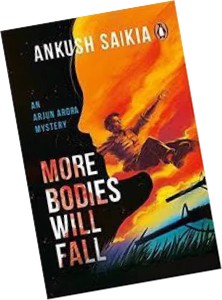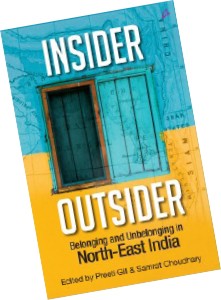Insider, Outsider A recent book about North-East India shows how ideas of belonging and unbelonging emerge and are often misplaced.
At the local beauty parlour recently I met a bespectacled 19-year-old whose disarming smile instantly got us chatting. “Are you from Nepal?” I asked, as she attended on my mani-pedi needs. “Darjeeling,” she replied. Right, I thought to myself, Nepali doesn’t mean she’s Nepali. Nepali means Indian too. And vice versa.
Of course, this little interaction is no metaphor for Insider Outsider: Belonging and Unbelonging in North-East India, a collection of writings edited by Preeti Gill and Samrat. Besides, Darjeeling is in West Bengal; we know that. However, it does pierce a pinhole into a largely unexamined slice of our political, geographic, social, economic and cultural history, among others, and by extension, the idea of India. The insights the book offers as you peruse its 17 entries are unsettling; they reiterate the lack — my lack, at any rate — of information, knowledge and sensitivity regarding an integral part of our country.
Coincidentally, just before I discovered this book at a bookstore, someone had asked me: Why do we use the term ‘north-east’ to describe the States of Assam, Meghalaya, Manipur, Mizoram, Tripura, Nagaland and Arunachal Pradesh? If Maharashtra, Gujarat and Rajasthan are ‘west’, and Bengal, Bihar, Sikkim ‘east’, these seven states are also ‘east’.
It’s a valid question, and attempting to answer it seems to only push the ‘North-East’ further away from India. We forget that these seven States were carved out fairly recently, and few remember or even know that Shillong, now the capital of Meghalaya, was once capital of a more all-encompassing Assam. But that’s not the only thing I learned from this book, although much of it recalls the city with an aching nostalgia, and is a mix of political and social history.
In recent years, young people from the region have moved to other parts of India in search of jobs and better opportunities. While some of them have settled comfortably, many others have been subjected to discrimination and abuse. Chinki and Momo are words often used to address or describe them, and nobody cares that they come from different States and tribes in the same way that anybody from south of the Vindhyas is a Madrasi. Or a non-tribal is dkhar in Shillong, bangal in Garo Hills, mayang in Manipur or vai in Mizoram. The presence in this region, predominantly of people of Bengali origin, is the source of the insider/outsider sentiment, and the book attempts to examine this in various ways through different eye and experiences.
I didn’t know, before reading Suhas Chakma’s essay titled Outsiders in Their Own Lands, that Chakmas, traditionally Buddhist, and other non-Muslims comprised 98.5 per cent of the population in the Chittagong Hill Tracts (CHTs) and had lived there for generations. When Partition happened, they wanted to be part of India, but the CHTs were given over to Pakistan. Soon, Chakmas living in undivided Assam, including Mizoram and Tripura, became targeted as foreigners. Those living in Arunachal Pradesh were safe for a while — until 1980 when the State government passed a resolution prohibiting their employment.
Most of us remember the unique protest by the ‘mothers’ of Manipur after a young woman, Thangjam Manorama, was raped and murdered while in army custody, and Irom Sharmila, who fasted for 16 years demanding the withdrawal of the AFSPA (Armed Forces Special Powers Act) giving the Army free rein in what the State deems a ‘disturbed area’. In Phenomenon of Impunity, Thounoujam Brinda shows how Manipur has been governed by a series of repressive ordinances affecting basic human rights of citizens, resulting in State brutality and a litany of officially sponsored massacres, even as, consequently, over 30 armed insurgent groups operate there today.
Home and identity are matters close to every human being’s heart. Mahua Sen (Chronicles of a Death Untold) and Ankush Saikia (Man in the Middle) examine home and identity in unique ways that touch the reader. As Mahua Sen writes, “The Bengali Hindu population of Shillong is the only community in India to have suffered double displacement on communal grounds, twice within a generation. We inherited the collective fate of the Punjabi Hindus of West Pakistan and the Kashmiri Pandits. In the majoritarian spectrum, if Kashmiri Pandits are the acne of secular India, the Bengali Hindu of Shillong is the genital wart. Nobody knows you have one.” When xenophobia was at its worst in Shillong from 1979 onward until the early 1990s, “the vital point deemed unworthy of consideration was that we were not conquerors. We were refugees with a right to citizenship.” She recalls the ghastly, cold-blooded rape and murder on the open streets of a pregnant Gauri Dey as she took a walk one fateful day in 1987. “Over the years,” Mahua writes, “I have reached a position where what happened in Shillong is less important than how the world chose to ignore it. Eventually, brutality will always be outplayed only by one other thing — the indifference of others towards that brutality. As descendants of refugees are bound to ask, who owns the land more than whom, and why?”
While we drive ourselves crazy over Kashmir, we ignore the cries of help emanating from the East. On what basis do we choose to listen to some voices, and not others, insider or outsider?
Saikia writes crime fiction and his detective, Arjun Arora, with a Punjabi father and a Nepali mother, comes with all the social history and personal baggage of such a lineage and its possible future course. This thread, says Saikia, runs through all the books featuring Arjun: Dead Meat, Remember Death, and More Bodies Will Fall. “It seemed to me,” Saikia explains, “that there was a good opportunity to treat through fiction, to dramatise the North-Eastern experience in Delhi (and also the outsider’s experience in the North-East), especially in the context of those vexed words one hears nowadays — ‘racism’ and ‘discrimination’.”
Chinki and Momo are words often used to address or describe people from the North East, in the same way that anybody from south of the Vindhyas is a Madrasi.
Other pieces talk about the transfer of Sylhet to what’s now Bangladesh, and with it a whole culture and way of life being displaced. We see the effects of colonialism and how early efforts by missionaries to communicate with local populations through publications in their own tongues made them standardise the languages in ways that often trivialised other languages and/or dialects. Language is an important tool, and very vulnerable to exploitation. Samrat, one of the editors of the book, provides this beautiful passage in ‘How We Got Here’: “The spoken language of the common people remained local dialects until mass media and mass education began to change that in the twentieth century… A traveller travelling from Sibsagar to Kolkata by boat … would encounter a gradual change in the spoken language, with Assamese changing by degrees into Bengali. En route, the traveller would hear Kamrupi dialects such as Goalpariya and Rajbongshi that have elements common to both standard Assamese and standard Bengali.”
This sense of a continuum, a gradual convergence that also contains divergence, is reiterated when Sanjoy Hazarika, in Insiders, Outsiders and Those In Between, refers to the joint citizenship of Indians and Myanmarese. Despite the preeminence of the Inner Line Permit, he discovers, people living on the 2,000-odd km border with Myanmar, especially in Nagaland, Mizoram and Manipur, can go 15 km into Myanmar without travel permits on the basis of a simple identity marker.
Contradictions, paradoxes, prejudices… all these prevail in abundance all over India. It just appears to be more pronounced in what we call the ‘North-East’ mainly because we know so little. Insider Outsider opens our eyes and our hearts. Meanwhile, I can’t wait to meet Arjun Arora.
The columnist is a children’s writer and senior journalist.


